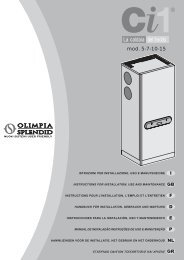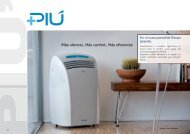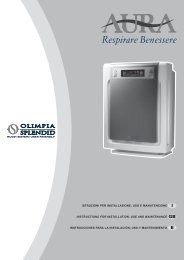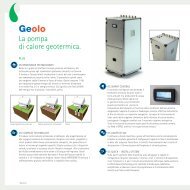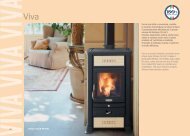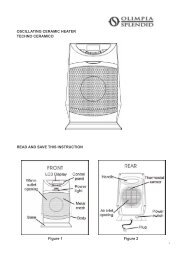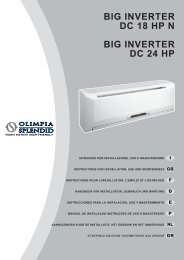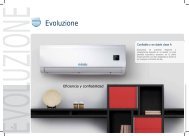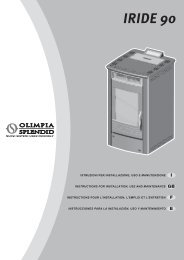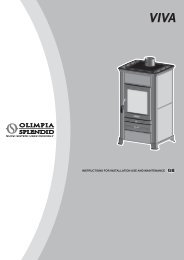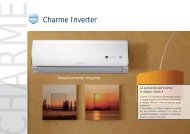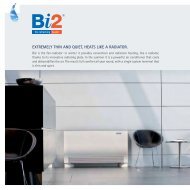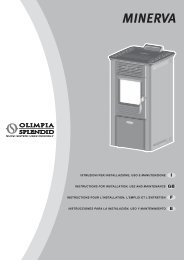Manuale Nuova Pellet.pmd - Olimpia Splendid
Manuale Nuova Pellet.pmd - Olimpia Splendid
Manuale Nuova Pellet.pmd - Olimpia Splendid
Create successful ePaper yourself
Turn your PDF publications into a flip-book with our unique Google optimized e-Paper software.
I<br />
C) deve indossare i guanti antiinfortunistici;<br />
D) deve indossare scarpe antiinfortunistiche;<br />
E) deve usufruire di utensili muniti di isolamento<br />
elettrico;<br />
F) deve accertarsi che l’area interessata alle fasi di<br />
montaggio e di smontaggio sia libera da ostacoli.<br />
5.2 CONSIDERAZIONI GENERALI<br />
Molti sono i fattori che concorrono per rendere efficace<br />
la combustione in termini di prestazioni termiche e basse<br />
emissioni di sostanze inquinati (CO - Monossido di<br />
carbonio).<br />
Alcuni fattori dipendono dall’apparecchiatura nella quale<br />
avviene la combustione altri invece dipendono da<br />
caratteristiche ambientali, di installazione e dal grado di<br />
manutenzione ordinaria effettuato sul prodotto.<br />
Alcuni fattori importanti sono:<br />
- aria comburente;<br />
- caratteristiche del sistema di evacuazione dei<br />
prodotti della combustione;<br />
- qualità del pellet (umidità e dimensioni).<br />
Nei paragrafi successivi sono riportate alcune indicazioni<br />
da rispettare per ottenere il massimo rendimento del<br />
prodotto acquistato.<br />
5.3 LUOGO DI INSTALLAZIONE DELLA STUFA<br />
In figura (Fig. 5.3.1) sono indicate le distanze minime<br />
che devono essere rispettate nel posizionamento della<br />
stufa rispetto a materiali e oggetti combustibili.<br />
A) Parete adiacente.<br />
B) Parete posteriore.<br />
C) Parete laterale.<br />
D) Protezione del pavimento.<br />
Proteggete dalle radiazioni calde del fuoco tutte le<br />
strutture che potrebbero incendiarsi se esposte a<br />
eccessivo calore.<br />
Pavimenti in legno o costituiti da materiale infiammabile,<br />
devono essere protetti con materiale non combustibile; ad<br />
esempio lamiera con spessore 2-3 mm.<br />
La protezione dovrà ricoprire tutta la zona del pavimento<br />
davanti alla stufa.<br />
GB<br />
C) he must wear accident prevention gloves;<br />
D) he must wear safety shoes;<br />
E) he must use electrically insulated tools;<br />
F) he must make sure that the area he is working in for<br />
assembling/dismantling the stove is free from<br />
obstacles.<br />
5.2 GENERAL CONSIDERATIONS<br />
There are many factors that contribute to good<br />
combustion in terms of heat performance and low<br />
emission of polluting substances (CO - carbon<br />
monoxide).<br />
Some of these factors depend on the stove itself while<br />
others depend on the environmental and installation<br />
conditions and on the routine maintenance carried out.<br />
Some of the important factors are:<br />
- air for combustion;<br />
- features of the combustion products evacuation<br />
system;<br />
- pellet quality (humidity content and size).<br />
Some indications are given in the following paragraphs<br />
that should be complied with to achieve maximum stove<br />
performance.<br />
5.3 WHERE TO INSTALL THE STOVE<br />
Figure 5.3.1 shows the minimum clearance there should<br />
be around the stove in relation to materials and<br />
flammable objects.<br />
A) Adjacent wall.<br />
B) Rear wall.<br />
C) Side wall.<br />
D) Floor protection.<br />
Protect all structures that could burn if exposed to the<br />
heat radiated by the stove.<br />
Wood flooring or floors made with flammable materials<br />
must be protected with a material that will not burn like,<br />
for instance, a 2-3 mm thick sheet of metal.<br />
Such protection should cover the whole floor in front of<br />
the stove.<br />
5.3.1<br />
28



